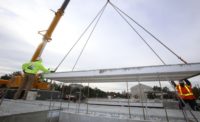Hydraulic Crane Doors Help CAID Industries Save Money, Time
Crane doors from Schweiss provide efficiency for new structure.

CAID Industries ordered two Schweiss hydraulic crane doors. The two photos above show the larger 61-foot, 6-inch door in the open and closed positions. The hydraulic door has a clear opening height of 8-feet, 4-inches.

CAID Industries ordered two Schweiss hydraulic crane doors. The two photos above show the larger 61-foot, 6-inch door in the open and closed positions. The hydraulic door has a clear opening height of 8-feet, 4-inches.

The Schweiss 44-foot, 10-inch x 6-foot, 11inch hydraulic one-piece crane door, shown opened and closed in the above photo is positioned above a sliding door. The crane doors were set up for 360v 3-phase electrical and can be opened and closed with handheld remote openers.





Report Abusive Comment